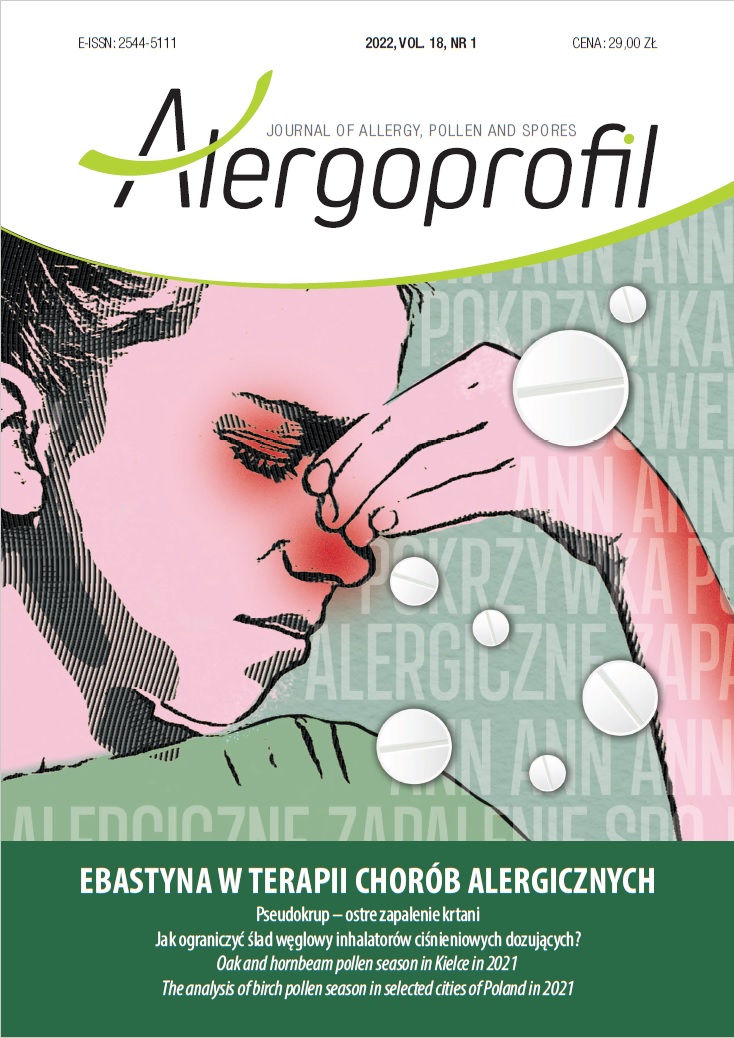Ebastyna w terapii chorób alergicznych Artykuł przeglądowy
##plugins.themes.bootstrap3.article.main##
Abstrakt
Choroby alergiczne należą do najczęstszych chorób przewlekłych dzieci, młodzieży i młodych dorosłych. Kluczowym mediatorem uwalnianym w ostrej fazie reakcji alergicznej jest histamina, która indukuje typowe objawy alergicznego nieżytu nosa (świąd nosa, kichanie), zapalenia spojówek (świąd, pieczenie, uczucie piasku pod powiekami) oraz pokrzywki (bąbel, rumień, świąd skóry). Do podstawowych leków objawowych stosowanych w terapii chorób alergicznych należą leki przeciwhistaminowe – blokery receptora H1. Ebastyna należy do nowoczesnych, wysoce selektywnych leków przeciwhistaminowych II generacji. Jest zarejestrowana w dawkach 10 mg i 20 mg w terapii objawów alergicznego nieżytu nosa i zapalenia spojówek u dzieci od 12. r.ż. i dorosłych oraz w dawce 10 mg w terapii pokrzywki u dorosłych. W szeregu badań klinicznych wykazano wysoką skuteczność ebastyny w redukcji nasilenia objawów sezonowego i całorocznego alergicznego nieżytu nosa, w tym wyraźny wpływ leku na blokadę nosa. Podobnie ebastyna charakteryzowała się dobrą skutecznością i optymalnym profilem bezpieczeństwa w terapii pokrzywki. Stwierdzono, że lek ten ma korzystny stosunek ryzyka do korzyści w odniesieniu do sedacji i nie ma istotnego klinicznie niekorzystnego wpływu na funkcje poznawcze lub psychomotoryczne. Ebastyna stanowi cenne uzupełnienie metod farmakoterapii chorób alergicznych w naszej codziennej praktyce klinicznej.
Pobrania
##plugins.themes.bootstrap3.article.details##

Utwór dostępny jest na licencji Creative Commons Uznanie autorstwa – Użycie niekomercyjne – Bez utworów zależnych 4.0 Międzynarodowe.
Copyright: © Medical Education sp. z o.o. This is an Open Access article distributed under the terms of the Attribution-NonCommercial 4.0 International (CC BY-NC 4.0). License (https://creativecommons.org/licenses/by-nc/4.0/), allowing third parties to copy and redistribute the material in any medium or format and to remix, transform, and build upon the material, provided the original work is properly cited and states its license.
Address reprint requests to: Medical Education, Marcin Kuźma (marcin.kuzma@mededu.pl)
Bibliografia
2. Bousquet J, Pfaar O, Togias A et al. 2019 ARIA care pathways for allergen immunotherapy. Allergy. 2019; 00: 1-16.
3. Samoliński B, Krzych-Fałta E, Piekarska B et al. ARIA 2019 – zintegrowana opieka w alergicznym nieżycie nosa – Polska. Alergologia Polska – Polish Journal of Allergology. 2019; 6(4): 111-26.
4. Kowalski ML, Bartuzi Z, Bręborowicz A et al. Stanowisko grupy ekspertów Polskiego Towarzystwa Alergologicznego w sprawie postepowania u chorych na astmę i choroby alergiczne w okresie pandemii SARS-CoV-2. Aktualizacja 01.06.2020. Alergologia Polska – Polish Journal of Allergology. 2020; 7(3): 117-30.
5. Hampel F, Howland S, Van Bavel J et al. A randomized, double- blind, placebo-controlled study comparing the efficacy and safety of ebastine (20 mg and 10 mg) to loratadine 10 mg once daily in the treatment of seasonal allergic rhinitis. J Investig Allergol Clin Immunol. 2004; 14(1): 56-63.
6. Ratner PH, Lim JC, Georges GC et al. Comparison of oncedaily ebastine 20 mg, ebastine 10 mg, loratadine 10 mg and placebo in the treatment of seasonal allergic rhinitis. J Allergy Clin Immunol. 2000; 105: 1101-7.
7. Gehanno P, Bernard-Oury C, Zeisser P. Comparison of ebastine to cetirizine in seasonal allergic rhinitis in adults. Ann Allergy Asthma Immunol. 1996; 76: 507-12.
8. Bousquet J, Gaudano EM, Palma Carlos AG et al. A 12-week, placebo controlled study of the efficacy and safety of ebastine, 10 and 20 mg once daily, in the treatment of perennial allergic rhinitis. Allergy. 1999; 54: 562-8.
9. Nowicki R, Grubska-Suchanek E, Jahnz-Różyk K et al. Pokrzywka. Interdyscyplinarne rekomendacje diagnostyczno-terapeutyczne Polskiego Towarzystwa Dermatologicznego i Polskiego Towarzystwa Alergologicznego. Alergologia Polska – Polish Journal of Allergology. 2020; 7(1): 31-9.
10. Antonijoan RM, García-Gea C, Puntes M et al. A comparison of ebastine 10 mg fast-dissolving tablet with oral desloratadine and placebo in inhibiting the cutaneous reaction to histamine in healthy adults. Clin Drug Investig. 2007; 27: 453-61.
11. Goyal V, Gupta A, Gupta O et al. Comparative efficacy and safety of ebastine 20 mg, ebastine 10 mg and levocetirizine 5 mg in acute urticaria. J Clin Diagn Res. 2017; 11: WC06-9.
12. Sanchez J, Zakzuk J, Cardona R. Prediction of the efficacy of antihistamines in chronic spontaneous urticaria based on initial suppression of the histamine-induced wheal. J Investig Allergol Clin Immunol. 2016; 26(3): 177-84.
13. van Steekelenburg J, Clement PA, Beel MH. Comparison of five new antihistamines (H1-receptor antagonists) in patients with allergic rhinitis using nasal provocation studies and skin tests. Allergy. 2002; 57: 346-50.
14. Wood-Baker R, Holgate ST. Dose-response relationship of the H1-histamine antagonist, ebastine, against histamine and methacholine- induced bronchoconstriction in patients with asthma. Agents Actions. 1990; 30: 284-6.
15. Horiguchi T, Tachikawa S, Kasahara J et al. Effect of ebastine on serum eosinophil cationic protein levels in patients with bronchial asthma. Clin Drug Invest. 1999; 17: 435-40.
16. Karppinen A, Kautiainen H, Petman L et al. Comparison of cetirizine, ebastine and loratadine in the treatment of immediate mosquito-bite allergy. Allergy. 2002; 57(6): 534.
17. Gillen MS, Miller B, Chaikin P et al. Effects of supratherapeutic doses of ebastine and terfenadine on the QT interval. Br J Clin Pharmacol. 2001; 52(2): 201-4.
18. Kawauchi H, Yanai K, Wang DY et al. Antihistamines for allergic rhinitis treatment from the viewpoint of nonsedative properties. Int J Mol Sci. 2019; 20(1): 213.
19. Sastre J. Ebastine in the treatment of allergic rhinitis and urticaria: 30 years of clinical studies and real-world experience. J Investig Allergol Clin Immunol. 2020; 30(3): 156-68.

